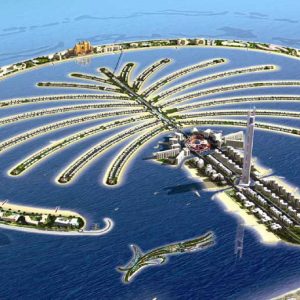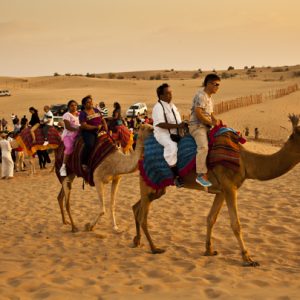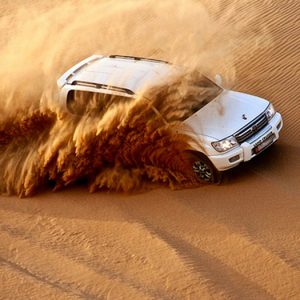Arab Emirates
Dubai is the most populous city in the United Arab Emirates(UAE). It is located on the southeast coast of the Persian Gulf and is one of the seven emirates that make up the country. Abu Dhabi and Dubai are the only two emirates to have veto power over critical matters of national importance in the country’s legislature. The city of Dubai is located on the emirate’s northern coastline and heads up the Dubai-Sharjah-Ajman metropolitan area. Dubai is to host World Expo 2020.
Dubai has emerged as a global city and business hub of the Middle East. It is also a major transport hub for passengers and cargo. By the 1960s Dubai’s economy was based on revenues from trade and, to a smaller extent, oil exploration concessions, but oil was not discovered until 1966. Oil revenue first started to flow in 1969. Dubai’s oil revenue helped accelerate the early development of the city, but its reserves are limited and production levels are low: today, less than 5% of the emirate’s revenue comes from oil. The emirate’s Western-style model of business drives its economy with the main revenues now coming from tourism, aviation, real estate, and financial services. Dubai has recently attracted world attention through many innovative large construction projects and sports events. The city has become iconic for its skyscrapers and high-rise buildings, in particular the world’s tallest building, the Burj Khalifa. Dubai has been criticized for human rights violations concerning the city’s largely South Asian workforce. Dubai’s property market experienced a major deterioration in 2008–09 following the financial crisis of 2007–08, but the emirate’s economy has made a return to growth, with a projected 2015 budget surplus.
As of 2012, Dubai is the 22nd most expensive city in the world and the most expensive city in the Middle East. In 2014, Dubai’s hotel rooms were rated as the second most expensive in the world, after Geneva. Dubai was rated as one of the best places to live in the Middle East by American global consulting firm Mercer.
Many theories have been proposed as to the origin of the word Dubai. One theory suggests the word was used to describe the souq, which was similar to the souq in Ba. Another theory states that the name came from a word meaning “money”, as people from Dubai were commonly believed to be rich due to the thriving trading center of the location. An Arabic proverb says “Daba Dubai“, meaning “They came with a lot of money.” According to Fedel Handhal, a scholar on the UAE’s history and culture, the word Dubai may have come from the worddaba a past tense derivative of yadub, which means “to creep”), referring to the slow flow of Dubai Creek inland. The poet and scholar Ahmad Mohammad Obaid traces it to the same word, but to its alternative meaning of “baby locust” due to the abundant nature of locusts in the area before settlement.
Although stone tools have been found at many archaeological sites, little is known about the UAE’s early inhabitants as only a few settlements have been found. Many ancient towns in the area were trading centers between the Eastern and Western worlds. The remnants of an ancient mangrove swamp, dated at 7000 BC, were discovered during the construction of sewer lines near Dubai Internet City. The area was covered with sand about 5,000 years ago as the coast retreated inland, becoming part of the city’s present coastline. Pre-Islamic ceramics have been found from the 3rd and 4th centuries. Prior to the introduction of Islam to the area, the people in this region worshiped Bajir (orBajar). After the spread of Islam in the region, the Umayyad Caliph of the eastern Islamic world invaded south-east Arabia and drove out the Sassanians. Excavations by the Dubai Museum in the region of Al-Jumayra (Jumeirah) found several artifacts from the Umayyad period.
The earliest recorded mention of Dubai is in 1095 in the Book of Geography by the Andalusian-Arabgeographer Abu Abdullah al-Bakri. The Venetian pearl merchant Gaspero Balbi visited the area in 1580 and mentioned Dubai (Dibei) for its pearling industry.
Dubai is thought to have been established as a fishing village in the early 18th century and was, by 1822, a town of some 7-800 members of the Baniyas tribe and subject to the rule of Sheikh Tahnoon of Abu Dhabi.
In 1833, following tribal feuding, members of the Al Bu Falasa tribe seceded from Abu Dhabi and established themselves in Dubai. The exodus from Abu Dhabi was led by Ubaid bin Saeed and Maktum bin Butti who became joint leaders of Dubai until Ubaid died in 1836, leaving Maktum to establish the Maktoum dynasty.
Dubai signed the treaty of ‘Perpetual Maritime Truce’ of 1853 along with other Trucial States and also – like its neighbours on the Trucial Coast – entered into an exclusivity agreement in which the United Kingdom took responsibility for the emirate’s security in 1892.
Two catastrophes struck the town during the 1800s. First, in 1841, a smallpox epidemic broke out in the Bur Dubai locality, forcing residents to relocate east to Deira. Then, in 1894, fire swept through Deira, burning down most homes. However, the town’s geographical location continued to attract traders and merchants from around the region. The emir of Dubai was keen to attract foreign traders and lowered trade tax brackets, which lured traders away from Sharjah and Bandar Lengeh, the region’s main trade hubs at the time. Persian merchants naturally looked across to the Arab shore of the Persian Gulf finally making their homes in Dubai. They continued to trade with Lingah, however, as do many of the dhows in Dubai Creek today, and they named their district Bastakiya, after the Bastak region in southern Persia
Pre-oil Dubai
Dubai’s geographical proximity to Iran made it an important trade location. The town of Dubai was an important port of call for foreign tradesmen, chiefly those from Iran, many of whom eventually settled in the town. By the beginning of the 20th century, it was an important port.
Dubai was known for its pearl exports until the 1930s; the pearl trade was damaged irreparably by the Great Depression in the 1930s and the innovation of cultured pearls. With the collapse of the pearling industry, Dubai fell into a deep depression and many residents starved or migrated to other parts of the Persian Gulf.
In the early days since its inception, Dubai was constantly at odds with Abu Dhabi. In 1947, a border dispute between Dubai and Abu Dhabi on the northern sector of their mutual border escalated into war. Arbitration by the British and the creation of a buffer frontier running south eastwards from the coast at Ras Hasian resulted in a temporary cessation of hostilities.
Despite a lack of oil, Dubai’s ruler from 1948, Sheikh Rashid bin Saeed Al Maktoum, used revenue from trading activities to build infrastructure. Electricity, telephone services, and an airport were established in Dubai in the 1950s and, in 1959, the emirate’s first hotel, the Airlines Hotel, was constructed. This was followed by the Ambassador and Carlton Hotel in 1968.
On 7 April 1961, the Dubai-based MV Dara, a five thousand ton British flagged vessel that plied the route between Basra (Iraq), Kuwait and Bombay (India), was caught in unusually high winds off Dubai. Early the next morning in heavy seas off Umm Al Qawain, an explosion tore out the second class cabins and started fires. The captain gave the order to abandon ship but two lifeboats capsized and a second explosion occurred. A flotilla of small boats from Dubai, Sharjah, Ajman and Umm Al Qawain picked up survivors but in all 238 lives were lost in the disaster.
In 1962 the British Political Agent noted that “Many new houses and blocks of offices and flats are being built… the Ruler is determined, against advice [from the British] to press on with the construction of a jet airport… More and more European and Arab firms are opening up and the future looks bright.”
The asphalt runway was constructed in 1965, opening Dubai to both regional and long haul traffic. In 1970 a new terminal building was constructed which included Dubai’s first duty-free shops
Oil era
After years of exploration following large finds in neighboring Abu Dhabi, oil was eventually discovered in territorial waters off Dubai in 1966, albeit in far smaller quantities. The first field was named ‘Fateh’ or ‘good fortune’. This led the emirate to grant concessions to international oil companies, thus igniting a massive influx of foreign workers, mainly Indians and Pakistanis. Between 1968 and 1975 the city’s population grew by over 300%.
As part of the infrastructure for pumping and transporting oil from the Fateh field, located offshore of the Jebel Ali area of Dubai, a number of 50,000 gallon storage tanks were built, known locally as ‘Kazzans’, by welding them together on the beach and then digging them out and floating them to drop onto the seabed at the Fateh field. These were constructed by the Chicago Bridge and Iron Company, which gave the beach its local name (Chicago Beach) until the Chicago Beach Hotel was demolished and replaced by the Jumeirah Beach Hotel in 1997.
Dubai had already embarked on a period of infrastructural development and expansion. Oil revenue, flowing from 1969 onwards supported a period of growth with Sheikh Rashid embarking on a policy of building infrastructure and a diversified trading economy before the emirate’s limited reserves were depleted. Oil accounted for 24% of GDP in 1990, but had reduced to 7% of GDP by 2004.
Critically, one of the first major projects Sheikh Rashid embarked upon when oil revenue started to flow was the construction of Port Rashid, a deep water free port constructed by British company Halcrow. Originally intended to be a four-berth port, it was extended to sixteen berths as construction was ongoing. The project was an outstanding success, with shipping queuing to access the new facilities. The port was inaugurated on 5 October 1972, although its berths were each pressed into use as soon as they had been built. Port Rashid was to be further expanded in 1975 to add a further 35 berths before the larger port of Jebel Ali was constructed.
Port Rashid was the first of a swathe of projects designed to create a modern trading infrastructure, including roads, bridges, schools and hospitals
Reaching the UAE’s Act of Union
Dubai and the other ‘Trucial States’ had long been a British protectorate where the British took care of foreign policy and defence, as well as arbitrating between the rulers of the Eastern Gulf. This was to change with PM Harold Wilson’s announcement, on 16 January 1968, that all British troops were to be withdrawn from ‘East of Aden’. The decision was to pitch the coastal emirates, together with Qatar and Bahrain, into fevered negotiations to fill the political vacuum that the British withdrawal would leave behind.
The principle of union was first agreed between the ruler of Abu Dhabi, Sheikh Zayed bin Sultan Al Nahyan, and Sheikh Rashid of Dubai on 18 February 1968 meeting in an encampment at Argoub Al Sedirah, near Al Semeih, a desert stop between the two emirates. The two agreed to work towards bringing the other emirates, including Qatar and Bahrain, into the union. Over the next two years, negotiations and meetings of the rulers followed -often stormy- as a form of union was thrashed out. The nine-state union was never to recover from the October 1969 meeting where heavy-handed British intervention resulted in a walk-out by Qatar and Ras Al Khaimah. Bahrain and Qatar were to drop out of talks, leaving only six emirates to agree on union on 18 July 1971.
On 2 December 1971, Dubai, together with Abu Dhabi, Sharjah, Ajman, Umm Al Qawain and Fujairah joined in the Act of Union to form theUnited Arab Emirates. The seventh emirate, Ras Al Khaimah, joined the UAE on 10 February 1972, following giant non-Arab neighbour Iran’s annexation of the RAK-owned Tunbs islands.
In 1973, Dubai joined the other emirates to adopt a uniform currency: the UAE dirham.[30] In 1973, the prior monetary union with Qatar was dissolved and the UAE Dirham was introduced throughout the Emirates.
Modern Dubai
During the 1970s, Dubai continued to grow from revenues generated from oil and trade, even as the city saw an influx of immigrants fleeing the Lebanese civil war. Border disputes between the emirates continued even after the formation of the UAE; it was only in 1979 that a formal compromise was reached that ended disagreements. The Jebel Ali port was established in 1979. JAFZA (Jebel Ali Free Zone) was built around the port in 1985 to provide foreign companies unrestricted import of labor and export capital.
The Gulf War of 1990 had a negative financial effect on the city, as depositors withdrew their money and traders withdrew their trade, but subsequently, the city recovered in a changing political climate and thrived. Later in the 1990s, many foreign trading communities—first fromKuwait, during the Gulf War, and later from Bahrain, during the Shia unrest—moved their businesses to Dubai. Dubai provided refueling bases to allied forces at the Jebel Ali Free Zone during the Gulf War, and again during the 2003 Invasion of Iraq. Large increases in oil prices after the Gulf War encouraged Dubai to continue to focus on free trade and tourism.Although stone tools have been found at many archaeological sites, little is known about the UAE’s early inhabitants as only a few settlements have been found. Many ancient towns in the area were trading centers between the Eastern and Western worlds. The remnants of an ancient mangrove swamp, dated at 7000 BC, were discovered during the construction of sewer lines near Dubai Internet City. The area was covered with sand about 5,000 years ago as the coast retreated inland, becoming part of the city’s present coastline. Pre-Islamic ceramics have been found from the 3rd and 4th centuries. Prior to the introduction of Islam to the area, the people in this region worshiped Bajir (orBajar). After the spread of Islam in the region, the Umayyad Caliph of the eastern Islamic world invaded south-east Arabia and drove out the Sassanians. Excavations by the Dubai Museum in the region of Al-Jumayra (Jumeirah) found several artifacts from the Umayyad period.
The earliest recorded mention of Dubai is in 1095 in the Book of Geography by the Andalusian-Arabgeographer Abu Abdullah al-Bakri. The Venetian pearl merchant Gaspero Balbi visited the area in 1580 and mentioned Dubai (Dibei) for its pearling industry.
Dubai is thought to have been established as a fishing village in the early 18th century and was, by 1822, a town of some 7-800 members of the Baniyas tribe and subject to the rule of Sheikh Tahnoon of Abu Dhabi.
In 1833, following tribal feuding, members of the Al Bu Falasa tribe seceded from Abu Dhabi and established themselves in Dubai. The exodus from Abu Dhabi was led by Ubaid bin Saeed and Maktum bin Butti who became joint leaders of Dubai until Ubaid died in 1836, leaving Maktum to establish the Maktoum dynasty.
Dubai signed the treaty of ‘Perpetual Maritime Truce’ of 1853 along with other Trucial States and also – like its neighbours on the Trucial Coast – entered into an exclusivity agreement in which the United Kingdom took responsibility for the emirate’s security in 1892.
Two catastrophes struck the town during the 1800s. First, in 1841, a smallpox epidemic broke out in the Bur Dubai locality, forcing residents to relocate east to Deira. Then, in 1894, fire swept through Deira, burning down most homes. However, the town’s geographical location continued to attract traders and merchants from around the region. The emir of Dubai was keen to attract foreign traders and lowered trade tax brackets, which lured traders away from Sharjah and Bandar Lengeh, the region’s main trade hubs at the time. Persian merchants naturally looked across to the Arab shore of the Persian Gulf finally making their homes in Dubai. They continued to trade with Lingah, however, as do many of the dhows in Dubai Creek today, and they named their district Bastakiya, after the Bastak region in southern Persia.
Pre-oil Dubai
Dubai’s geographical proximity to Iran made it an important trade location. The town of Dubai was an important port of call for foreign tradesmen, chiefly those from Iran, many of whom eventually settled in the town. By the beginning of the 20th century, it was an important port.
Dubai was known for its pearl exports until the 1930s; the pearl trade was damaged irreparably by the Great Depression in the 1930s and the innovation of cultured pearls. With the collapse of the pearling industry, Dubai fell into a deep depression and many residents starved or migrated to other parts of the Persian Gulf.
In the early days since its inception, Dubai was constantly at odds with Abu Dhabi. In 1947, a border dispute between Dubai and Abu Dhabi on the northern sector of their mutual border escalated into war. Arbitration by the British and the creation of a buffer frontier running south eastwards from the coast at Ras Hasian resulted in a temporary cessation of hostilities.
Despite a lack of oil, Dubai’s ruler from 1948, Sheikh Rashid bin Saeed Al Maktoum, used revenue from trading activities to build infrastructure. Electricity, telephone services, and an airport were established in Dubai in the 1950s and, in 1959, the emirate’s first hotel, the Airlines Hotel, was constructed. This was followed by the Ambassador and Carlton Hotel in 1968.
On 7 April 1961, the Dubai-based MV Dara, a five thousand ton British flagged vessel that plied the route between Basra (Iraq), Kuwait and Bombay (India), was caught in unusually high winds off Dubai. Early the next morning in heavy seas off Umm Al Qawain, an explosion tore out the second class cabins and started fires. The captain gave the order to abandon ship but two lifeboats capsized and a second explosion occurred. A flotilla of small boats from Dubai, Sharjah, Ajman and Umm Al Qawain picked up survivors but in all 238 lives were lost in the disaster.
In 1962 the British Political Agent noted that “Many new houses and blocks of offices and flats are being built… the Ruler is determined, against advice [from the British] to press on with the construction of a jet airport… More and more European and Arab firms are opening up and the future looks bright.”
The asphalt runway was constructed in 1965, opening Dubai to both regional and long haul traffic. In 1970 a new terminal building was constructed which included Dubai’s first duty-free shops.
Oil era
After years of exploration following large finds in neighboring Abu Dhabi, oil was eventually discovered in territorial waters off Dubai in 1966, albeit in far smaller quantities. The first field was named ‘Fateh’ or ‘good fortune’. This led the emirate to grant concessions to international oil companies, thus igniting a massive influx of foreign workers, mainly Indians and Pakistanis. Between 1968 and 1975 the city’s population grew by over 300%.
As part of the infrastructure for pumping and transporting oil from the Fateh field, located offshore of the Jebel Ali area of Dubai, a number of 50,000 gallon storage tanks were built, known locally as ‘Kazzans’, by welding them together on the beach and then digging them out and floating them to drop onto the seabed at the Fateh field. These were constructed by the Chicago Bridge and Iron Company, which gave the beach its local name (Chicago Beach) until the Chicago Beach Hotel was demolished and replaced by the Jumeirah Beach Hotel in 1997.
Dubai had already embarked on a period of infrastructural development and expansion. Oil revenue, flowing from 1969 onwards supported a period of growth with Sheikh Rashid embarking on a policy of building infrastructure and a diversified trading economy before the emirate’s limited reserves were depleted. Oil accounted for 24% of GDP in 1990, but had reduced to 7% of GDP by 2004.
Critically, one of the first major projects Sheikh Rashid embarked upon when oil revenue started to flow was the construction of Port Rashid, a deep water free port constructed by British company Halcrow. Originally intended to be a four-berth port, it was extended to sixteen berths as construction was ongoing. The project was an outstanding success, with shipping queuing to access the new facilities. The port was inaugurated on 5 October 1972, although its berths were each pressed into use as soon as they had been built. Port Rashid was to be further expanded in 1975 to add a further 35 berths before the larger port of Jebel Ali was constructed.
Port Rashid was the first of a swathe of projects designed to create a modern trading infrastructure, including roads, bridges, schools and hospitals
Reaching the UAE’s Act of Union
Dubai and the other ‘Trucial States’ had long been a British protectorate where the British took care of foreign policy and defence, as well as arbitrating between the rulers of the Eastern Gulf. This was to change with PM Harold Wilson’s announcement, on 16 January 1968, that all British troops were to be withdrawn from ‘East of Aden’. The decision was to pitch the coastal emirates, together with Qatar and Bahrain, into fevered negotiations to fill the political vacuum that the British withdrawal would leave behind.
The principle of union was first agreed between the ruler of Abu Dhabi, Sheikh Zayed bin Sultan Al Nahyan, and Sheikh Rashid of Dubai on 18 February 1968 meeting in an encampment at Argoub Al Sedirah, near Al Semeih, a desert stop between the two emirates. The two agreed to work towards bringing the other emirates, including Qatar and Bahrain, into the union. Over the next two years, negotiations and meetings of the rulers followed -often stormy- as a form of union was thrashed out. The nine-state union was never to recover from the October 1969 meeting where heavy-handed British intervention resulted in a walk-out by Qatar and Ras Al Khaimah. Bahrain and Qatar were to drop out of talks, leaving only six emirates to agree on union on 18 July 1971.
On 2 December 1971, Dubai, together with Abu Dhabi, Sharjah, Ajman, Umm Al Qawain and Fujairah joined in the Act of Union to form theUnited Arab Emirates. The seventh emirate, Ras Al Khaimah, joined the UAE on 10 February 1972, following giant non-Arab neighbour Iran’s annexation of the RAK-owned Tunbs islands.
In 1973, Dubai joined the other emirates to adopt a uniform currency: the UAE dirham.[30] In 1973, the prior monetary union with Qatar was dissolved and the UAE Dirham was introduced throughout the Emirates.
Modern Dubai
During the 1970s, Dubai continued to grow from revenues generated from oil and trade, even as the city saw an influx of immigrants fleeing the Lebanese civil war. Border disputes between the emirates continued even after the formation of the UAE; it was only in 1979 that a formal compromise was reached that ended disagreements. The Jebel Ali port was established in 1979. JAFZA (Jebel Ali Free Zone) was built around the port in 1985 to provide foreign companies unrestricted import of labor and export capital.
The Gulf War of 1990 had a negative financial effect on the city, as depositors withdrew their money and traders withdrew their trade, but subsequently, the city recovered in a changing political climate and thrived. Later in the 1990s, many foreign trading communities—first fromKuwait, during the Gulf War, and later from Bahrain, during the Shia unrest—moved their businesses to Dubai. Dubai provided refueling bases to allied forces at the Jebel Ali Free Zone during the Gulf War, and again during the 2003 Invasion of Iraq. Large increases in oil prices after the Gulf War encouraged Dubai to continue to focus on free trade and tourism.
Dubai is situated on the Persian Gulf coast of the United Arab Emirates and is roughly at sea level (16 m or 52 ft above). The emirate of Dubai shares borders with Abu Dhabi in the south, Sharjah in the northeast, and the Sultanate of Oman in the southeast. Hatta, a minor exclave of the emirate, is surrounded on three sides by Oman and by the emirates of Ajman (in the west) and Ras Al Khaimah (in the north). The Persian Gulf borders the western coast of the emirate. Dubai is positioned at25.2697°N 55.3095°E and covers an area of 1,588 sq mi (4,110 km2), which represents a significant expansion beyond its initial 1,500 sq mi (3,900 km2) designation due to land reclamation from the sea.
Dubai lies directly within the Arabian Desert. However, the topography of Dubai is significantly different from that of the southern portion of the UAE in that much of Dubai’s landscape is highlighted by sandy desert patterns, while gravel deserts dominate much of the southern region of the country. The sand consists mostly of crushed shell and coral and is fine, clean and white. East of the city, the salt-crusted coastal plains, known as sabkha, give way to a north-south running line of dunes. Farther east, the dunes grow larger and are tinged red with iron oxide.
The flat sandy desert gives way to the Western Hajar Mountains, which run alongside Dubai’s border with Oman at Hatta. The Western Hajar chain has an arid, jagged and shattered landscape, whose mountains rise to about 1,300 metres (4,265 feet) in some places. Dubai has no natural river bodies or oases; however, Dubai does have a natural inlet, Dubai Creek, which has been dredged to make it deep enough for large vessels to pass through. Dubai also has multiple gorges and waterholes, which dot the base of the Western Al Hajar mountains. A vast sea of sand dunes covers much of southern Dubai and eventually leads into the desert known as The Empty Quarter. Seismically, Dubai is in a very stable zone—the nearest seismic fault line, the Zagros Fault, is 200 kilometres (124 miles) from the UAE and is unlikely to have any seismic impact on Dubai. Experts also predict that the possibility of a tsunami in the region is minimal because the Persian Gulf waters are not deep enough to trigger a tsunami.
The sandy desert surrounding the city supports wild grasses and occasional date palms. Desert hyacinths grow in the sabkha plains east of the city, while acacia and ghaf trees grow in the flat plains within the proximity of the Western Al Hajar mountains. Several indigenous trees such as the date palm and neem as well as imported trees such as the eucalypts grow in Dubai’s natural parks. The houbara bustard, striped hyena, caracal, desert fox, falcon and Arabian oryx are common in Dubai’s desert. Dubai is on the migration path between Europe, Asia and Africa, and more than 320 migratory bird species pass through the emirate in spring and autumn. The waters of Dubai are home to more than 300 species of fish, including the hammour. The typical marine life off the Dubai coast includes tropical fish, jellyfish, coral, dugong, dolphins, whales and sharks. Various types of turtles can also be found in the area including the hawksbill turtle and green turtle, which are listed as endangered species.
Dubai Creek runs northeast-southwest through the city. The eastern section of the city forms the locality of Deira and is flanked by the emirate of Sharjah in the east and the town of Al Aweer in the south. The Dubai International Airport is located south of Deira, while the Palm Deira is located north of Deira in the Persian Gulf. Much of Dubai’s real-estate boom is concentrated to the west of Dubai Creek, on the Jumeirahcoastal belt. Port Rashid, Jebel Ali, Burj Al Arab, the Palm Jumeirah and theme-based free-zone clusters such as Business Bay are all located in this section.
Dubai has a hot desert climate. Summers in Dubai are extremely hot, windy, and humid, with an average high around 41 °C (106 °F) and overnight lows around 30 °C (86 °F) in the hottest month, August. Most days are sunny throughout the year. Winters are warm with an average high of 24 °C (75 °F) and overnight lows of 14 °C (57 °F) in January, the coldest month. Precipitation, however, has been increasing in the last few decades, with accumulated rain reaching 94.3 mm (3.71 in) per year. Dubai summers are also known for the moderate to high humidity level, which can make it uncomfortable for many. The highest recorded temperature in Dubai is 52.1 °C (126 °F), reached in July 200.
wordpress theme by initheme.com
Total: 1 tour . Showing 1 - 1 view all
Search for Tour
Not what you're looking for? Try your search again









